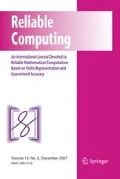Abstract
During the past few years the interest paid to global optimization has rapidly increased. One of the main reasons is the new technology of parallel computers which offer computational power capable of solving global optimization problems in reasonable time. The method studied in this work is based on interval analysis which provides a reliable way for solving the problem. Despite the fact that the method contains a high degree of potential parallelism, it is not straight forward to parallelize due to its irregular and unpredictable computational behaviour. This paper deals with the problem of balancing the load dynamically, both with respect to the quantity and to the quality of the tasks. Efficient strategies are proposed and implemented on an Intel iPSC/2 hypercube. Since the sequential algorithm is used as a base it will be modified to suit the parallel algorithm.
Abstract
В течение ностедних нескольких пег ннтерес к нроблеме глобальной онтимнзанин быстро возрастал. Олна нз основных врнчин этого — нобые технологии параллельных компьютеров, обеспечнваюппе аостаточвую вычнслительную мощность для решения залач глоза глобальной онтнмизации за разумное время. Мегол, рассмотренный в данной работе, оснонан на интервальном анализе, которьй овеснечивает надежный нуть решения залачи. Несмотря на значительную до←ю нотенниадьного параллелизма в зтом метоле, его параллелизация ирелставляет собой хетрнвиальную залачу нз-за нерегулярного и непрелсказуемого хола вычислений. Настоящая рабога рассматривает проб←ему динамического балаисирования иагрузки с учетом как качества, так и количества залач. Преллаіаются зффектнiвные стратетии решения в оиисывается их реализация на гинеркуве Intel iPSC/2. ПосколЧjку в качестве вiсходного исиользуется нонользуется иослеловательный алгоритм, он будет модифниирован, что нозводит всхользовать ето как иараллельный.
Similar content being viewed by others
References
Caprani, O. and Madsen, K.Experiments with interval methods for nonlinear systems. Technical report. Institute fur Angewandte Mathematik, Universität Frieburg i. Br., Copenhagen, 1981.
Caprani, O. and Madsen, K.Introduktion til interval analyse. Institute of Datalogy, University of Copenhagen, 1981.
Eriksson, J.Improvements of the interval method for solving the global optimization problem. UMINF-report. Information Processing, University of Umeå, 1991.
Eriksson, J.Parallel global optimzation using interval analysis. UMINF-report, Information Processing. University of Umeå, 1991.
Eriksson, J.Improvements of the interval method for solving the global optimzation, problem. UMINF-report. Information Processing, University of Umeå, 1991.
Eriksson, J.Parallel global optimzation using interval analysis. UMINF-report, Information Processing, University of Umeå, 1991.
Eriksson, J.Parallel global optimization using interval analysis on iPSC/2 (Draft). UMINF-report, Information Processing, University of Umeå, 1990.
Felten, E. W.Best-first branch-and-bound on a hypercube. In: “Conference on Hypercube Concurrent Computers and Applications, 1”, ACM, 1988, pp. 1500–1504.
Hansen, E.Global optimization using interval analysis—the multi-dimensional case. Numerische Mathematik34 (1980), pp. 247–270.
Krawczyk, R.Newton-Algorithmen zur Bestimmung von Nullstellen mit Fehlerschranken. Computing4 (1969), pp. 187–201.
Lai and Sahni.Anomalies in parallel branch-and-bound algorithms. Communications of the ACM27 (6) (1984), pp. 594–602.
Lin, F. C. and Keller, R. M.Gradient model: a demand-driven load balancing scheme. In: “IEEE Conf. on Distributed Systems”, 1984, pp. 337–357.
Moore, R. E.A computational lest for convergence of iterative methods for nonlinear systems. SIAM Journal on Numerical Analysis15 (6) (1978), pp. 1194–1196.
Moore, R. E.A test for existence of solutions to nonlinear systems. SIAM Journal on Numerical Analysis14 (4) (1977), pp. 611–615.
Moore, R. E.Interval analysis. Prentice Hall, Englewood Cliffs, 1966.
Ranka, S., Won, Y., and Sahni, S.Programming a hypercube multicomputer. IEEE Software, 1988, pp. 69–77.
Ratschek, H. and Rokne, J.New computer methods for global optimization. Ellis Horwood, Chichester, 1988.
Ratchek, H. and Voller, R. L.What can interval analysis do for global optimization. J. of Global Optimization1 (2) (1991), pp. 111–130.
Thoft-Christensen, J.Global optimering på paralleldalamal. Masters thesis. Numerical Institute in Copenhagen, 1989.
Walster, G. W., Hansen, E., and Sengupta, S.Test results for a global optimization algorithm. In: Boggs, Byrd, and Schnabel (eds) “Numerical Optimization”, SIAM J. on Scientific and 72–287.
Author information
Authors and Affiliations
Rights and permissions
About this article
Cite this article
Eriksson, J., Lindström, P. A parallel interval method implementation for global optimization using dynamic load balancing. Reliable Comput 1, 77–91 (1995). https://doi.org/10.1007/BF02390523
Received:
Issue Date:
DOI: https://doi.org/10.1007/BF02390523




